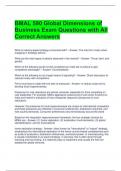BMAL 590 Global Dimensions of
Business Exam Questions with All
Correct Answers
What is industry-based strategy concerned with? - Answer- The inter-firm rivalry when
engaging in strategic actions
What are the main types of attacks observed in the market? - Answer- Thrust, feint, and
gambit.
Which of the following would not be considered an initial set of actions to gain
competitive advantage? - Answer- Counterattacks
Which of the following is not a legal means of signaling? - Answer- Direct discussion of
reduced rivalry with competitors.
Firms must learn to deal with two sets of pressures - Answer- to reduce costs and to
develop local responsiveness.
Pressures for cost reductions are almost universal, especially for firms competing on
cost leadership. For example, MNEs aggressive outsourcing of call center functions to
India and Ireland is indicative of how companies respond to pressures for cost
reductions.
However, the pressures for local responsiveness are unique to international competition
and these pressures are reflected in consumer preferences, distribution channels, and
host country demands. Consumer preferences vary tremendously around the world
Based on the integration-responsiveness framework, the four strategic choices for
MNEs are - Answer- (1) home replication, (2) localization (multi-domestic), (3) global
standardization, and (4) transnational
home replication strategy - Answer- often known as "international" or "export" strategy,
emphasizes the international replication of the home country-based competencies such
as scale of production, distribution efficiencies, and brand power. In manufacturing, this
is usually manifested in an export strategy. In services, this is often done through
licensing and franchising. It is relatively easy to implement and usually the first one
adopted for global ventures.
,localization (multi-domestic) strategy is - Answer- an extension of the home replication
strategy and focuses on a number of foreign countries/regions, each of which is
regarded as a stand-alone "domestic" market worthy of attention and adaptation.
Although this choice sacrifices global efficiencies, it is effective when there are clear
differences among national and regional markets and low pressures for cost reductions;
a multi-domestic strategy comes at higher costs.
Global standardization strategy - Answer- the opposite of the multi-domestic strategy
and is sometimes referred to as "global strategy." Its hallmark is the development and
distribution of standardized products worldwide in order to reap the maximum benefits
from low-cost advantages. The MNE may designate "centers of excellence,"
subsidiaries recognized as a source of important capabilities, so these capabilities can
be leveraged and/or disseminated to other subsidiaries.
Transnational strategy - Answer- aims to capture "the best of both worlds" by
endeavoring to be both cost efficient and locally responsive. In addition, this choice also
facilitates global learning and diffusion of innovations.
The International Division Structure - Answer- typically set up when firms initially expand
abroad, often engaging in a home replication strategy. Problems inherent in this
organizational structure are two-fold: (1) Foreign subsidiary managers in the
international division are not given sufficient voice relative to the heads of domestic
divisions. (2) The "silo" effect appears because international division activities are not
coordinated with the rest of the firm, which focuses on domestic activities. Firms often
phase out this structure after their initial overseas expansion.
The Geographic Area Structure - Answer- the most appropriate structure for a multi-
domestic strategy. This structure organizes the MNE according to different geographic
areas (countries and regions) where its ability to facilitate local responsiveness is both a
strength and a weakness. Since being locally responsive can be a virtue, it may also
encourage the fragmentation of the MNE into highly autonomous, hard-to-control
"fiefdoms."
The Global Product Division Structure - Answer- which is the opposite of the geographic
area structure, supports a global strategy in treating each product division as a stand-
alone entity with full worldwide—as opposed to domestic—responsibilities for its
activities. This structure helps firms focus attention on pressures for cost efficiencies in
allowing for consolidation on a worldwide (or regional) basis and reduction of inefficient
duplication in multiple countries but has little local responsiveness. For example,
Unilever reduced the number of its soap-producing factories in Europe from ten to two
after adopting this structure.
Global Matrix Structure - Answer- often used to alleviate the disadvantages associated
with both geographic area and global product division structures. Its hallmark is sharing
and coordinating responsibilities between product divisions and geographic areas to be
, both cost efficient and locally responsive. It is intended to support the goals of the
transnational strategy; in practice, it is often difficult to deliver because it may add layers
of management, slow down decision speed, and increase costs while not showing
significant performance improvement. Many MNEs have tried to build a "flexible" matrix
structure. No conclusive evidence supports the superiority of the matrix structure.
Three key ideas stand out when reviewing multinational strategies and structures: -
Answer- (1) Strategy drives structure. A mismatch, such as combining a global strategy
with a geographic area structure, may have poor performance consequences.
(2) The relationship between the two is two-way. To the extent that certain strategies
facilitate certain structures, a given structure also supports a particular strategy.
(3) Strategies and structures are not static. The constant changes in industry conditions,
firm capabilities, and institutional environments often require strategies, structures, or
both to change.
A Summary of the Five Forces Framework: - Answer- Rivalry among competitors
Threat of entrants
Bargaining power of suppliers
Bargaining power of buyers
Threat of substitutes
Knowledge Management in Four Types of MNEs - Answer- Knowledge management
can be defined as the structures, processes, and systems that actively develop,
leverage, and transfer knowledge.
Knowledge management is significantly impacted by the interdependence of the MNE.
In MNEs pursuing a home replication strategy, such interdependence is moderate and
the role of subsidiaries is largely to adapt and leverage parent company competencies.
Thus, knowledge of new products, processes, and technologies is mostly developed at
the center and flows to subsidiaries, representing the traditional one-way flow.
The two types of knowledge - Answer- explicit and tacit
Explicit knowledge is codifiable; that is, it can be written down and transferred without
losing much of its richness.
tacit knowledge is non-codifiable and its acquisition and transfer require hands-on
practice. Tacit knowledge is more important and harder to transfer and learn.
Consequently, from a resource-based view, explicit knowledge captured by IT may be
strategically less important. What counts is the hard-to-codify and hard-to-transfer tacit
knowledge.





